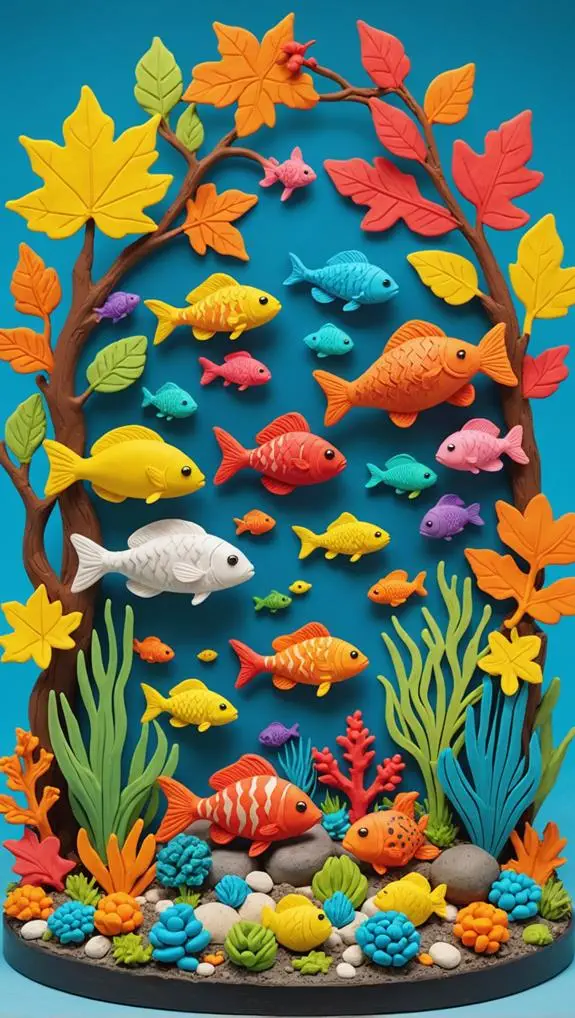Following seasonal feeding guidelines for your aquarium fish isn't just about keeping them full—it's essential for their health and happiness! When temperatures rise, fish tend to get hungrier and more active, so they need a richer diet. But as it cools down, their appetite dips and they might slow down, meaning it's time to cut back a bit. Adjusting their food helps prevent overfeeding, which can mess with water quality. Plus, it encourages their natural behaviors and keeps your aquatic buddies thriving. Stick around, and you'll discover even more tips to nurture your underwater friends!
Contents
Understanding Seasonal Changes
Understanding seasonal changes is crucial for maintaining a healthy aquarium environment. As an aquarist, you need to recognize how shifts in water temperature and levels can affect your tropical fish's metabolism, activity, and feeding patterns.
In spring and summer, warmer water temperatures often boost your fish's appetite and energy. Warmer water also reduces dissolved oxygen levels, making it vital to monitor these conditions closely. They're like kids at a buffet—ready to eat! During this time, food availability increases, with fish enjoying a diet rich in invertebrates temperature impacts fish health.
However, when autumn and winter roll around, things change. The cooler water temperatures can slow your fish down, leading to a reduced appetite. It's essential to adjust your feeding frequency accordingly, ensuring that you don't overfeed during these slower months.
Moreover, understanding these seasonal influences helps you keep the water quality optimal, creating a more natural habitat for your fish. For example, tropical fish like cichlids and Corydoras may even breed when temperatures rise slightly.
Importance of Temperature Management
Temperature management plays a vital role in your aquarium's overall health. When you keep an eye on the water temperature, you're not just doing a chore; you're creating a nurturing environment for your fish. Warm water can have lower oxygen levels, which might stress your fish and affect their metabolism.
Stable temperatures support fish health, and let's be honest, no one wants a stressed-out fish!
During the breeding season, slight increases in temperature can trigger those romantic vibes for species like cichlids. Meanwhile, Corydoras prefer cooler temps for their own love stories. Isn't it fascinating how temperature influences fish behavior?
Seasonal fluctuations can also lead to changes in metabolic rates, affecting feeding habits.
Nutritional Needs Throughout the Year

Aquarium fish have unique nutritional needs that change throughout the year, influenced by seasonal temperature shifts and corresponding metabolic rates. As a caring aquarium keeper, you'll want to pay attention to these changes to ensure your fish thrive.
During the warm months of spring and summer, many fish species become more active and hungry, often shifting to a varied diet that includes insects and algae, which complements their natural feeding behaviors. Just remember, with increased appetite comes the risk of overfeeding, which can lead to poor water quality; thus, maintaining an optimal tank environment is crucial.
When the seasons shift to autumn and winter, fish typically slow down. Many species enter a dormancy phase, requiring far less food due to lower metabolic rates. This is the perfect time to reduce feeding and adjust your practices accordingly.
Additionally, the availability of food sources changes with the wet and dry seasons. Fish might feast on invertebrates during the wet season but switch to algae and detritus when water levels drop. By following seasonal feeding guidelines, you'll not only keep your fish healthy but also boost their reproductive success, making your aquarium a lively, thriving ecosystem!
Behavioral Adaptations in Fish
How do fish adapt their behaviors to seasonal changes? Just like us, fish respond to the shifts in their environment, affecting their activity levels and feeding habits. Understanding these adaptations can help you provide better care for your aquatic life.
- Spring Awakening: As the water warms, fish ramp up their activity. You'll notice more courtship and territorial displays as they prepare for spawning.
- Summer Feast: With optimal digestion conditions, fish tend to eat like there's no tomorrow! But watch out—overfeeding can lead to water quality issues due to excess waste.
- Autumn Preparation: As temperatures drop, fish start to cut back on food. They focus on high-protein diets to build energy reserves for the winter months ahead.
During winter, many fish enter a state of dormancy with lower water activity and minimal feeding needs.
It's crucial to maintain consistent water quality and stable temperatures. Also, consider adjusting your lighting systems to mimic natural conditions, helping your fish feel more at home.
Enhancing Aquarium Ecosystem Health

Regularly enhancing the health of your aquarium ecosystem is essential for keeping your fish thriving. By following seasonal feeding guidelines, you're aligning with their natural behaviors. This means your fish can digest food more effectively and manage their energy as water temperatures change throughout the year.
When you adjust their diets—like providing high-protein options in warmer months and cutting back in winter—you promote their optimal health and resilience against stress.
These seasonal feeding practices also improve water quality. By preventing excess waste and uneaten food, you help maintain a clean environment that supports healthy ecosystem dynamics.
Plus, your fish will feel more at home, as they can engage in natural behaviors like foraging and breeding. Just imagine your little aquatic buddies getting all excited about food like kids at a candy store!
Implementing these feeding strategies fosters a balanced aquarium. It encourages nutrient cycling and supports beneficial microorganisms, vital for overall ecosystem health.
So, not only are you serving your fish, but you're also creating a thriving aquatic community.
Trust me, your fish will thank you, and you'll feel like a superstar aquarist!
Frequently Asked Questions
What Are the Guidelines for Feeding Fish?
To ensure optimal fish growth, you should monitor feeding behavior and make seasonal adjustments. Offer varied food types, maintaining a nutrient balance that aligns with their metabolic needs throughout different times of the year.
Do Fish Need to Be Fed on a Schedule?
Yes, feeding fish on a schedule aligns with their behavior and nutritional needs. Adjusting feeding frequency based on environmental factors supports their growth stages, ensuring they thrive while maintaining a healthy aquarium ecosystem for everyone.
What Is the Feeding Schedule for Aquarium Fish?
You'll notice your fish's behavior changes with the seasons. Adjust feeding frequency to match their dietary preferences and nutrient requirements, ensuring you provide the right food for their seasonal variations and energy needs.
What Is the Feeding Strategy for Fish?
To enhance nutrient absorption, adjust your feeding strategy based on water temperature and fish species. Recognize their growth stages and feeding behavior, ensuring you provide appropriate portions that cater to their specific needs for optimal health.
Final Thoughts
So, why not give your fish the best care possible? Following seasonal feeding guidelines helps you keep their health and happiness in check as their needs change throughout the year. By understanding their behaviors and nutritional needs, you're not just feeding them; you're creating a thriving underwater world. Imagine how happy your fish will be, swimming around like they own the place! With a little attention, you can make your aquarium a vibrant, healthy home for your finned friends.












